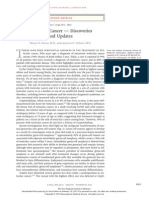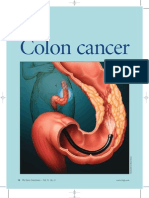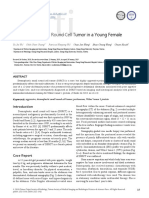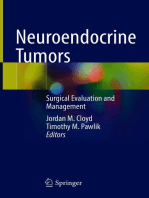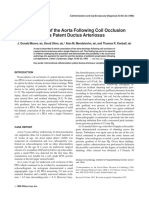Metastatic Renal Cell Carcinoma in A Child: 11-Year Disease-Free Survival Following Surgery
Metastatic Renal Cell Carcinoma in A Child: 11-Year Disease-Free Survival Following Surgery
Uploaded by
Sarly FebrianaCopyright:
Available Formats
Metastatic Renal Cell Carcinoma in A Child: 11-Year Disease-Free Survival Following Surgery
Metastatic Renal Cell Carcinoma in A Child: 11-Year Disease-Free Survival Following Surgery
Uploaded by
Sarly FebrianaOriginal Title
Copyright
Available Formats
Share this document
Did you find this document useful?
Is this content inappropriate?
Copyright:
Available Formats
Metastatic Renal Cell Carcinoma in A Child: 11-Year Disease-Free Survival Following Surgery
Metastatic Renal Cell Carcinoma in A Child: 11-Year Disease-Free Survival Following Surgery
Uploaded by
Sarly FebrianaCopyright:
Available Formats
Medical and Pediatric Oncology 28:201–204 (1997)
Metastatic Renal Cell Carcinoma in a Child:
11-Year Disease-Free Survival Following Surgery
Ron Grant, MD, FRCPC,1,2 Cynthia Trevenen, MD, FRCPC,3
William C. Hyndman, MD, FRCSC,4 Steven Z. Rubin, MD, FRCS(E), FRCSC,4 and
Max J. Coppes, MD, PhD1,2
A child with metastatic renal cell carcinoma agement of metastatic RCC is reviewed and
(RCC) is presented. This case is unusual in that the genetic mechanisms leading to its develop-
the patient has remained disease free for 11 ment briefly discussed. Med. Pediatr. Oncol.
years following surgery and only one course of 28:201–204 Q 1997 Wiley-Liss, Inc.
chemotherapy prior to thoracotomy. The man-
Key words: renal cell carcinoma; childhood; survival; genetics
INTRODUCTION in the periphery of the lower left lobe, consistent with a
metastatic lesion. Subsequently, a computed axial tomog-
Renal cell carcinoma (RCC) represents approximately
raphy (CAT) scan of the chest confirmed the presence of
2% of all new adult cancers [1]. By contrast, RCC is
the lesion in the lower left lung. In addition, a second,
very rare in children and accounts for less than 0.05%
0.6 cm, well-defined nodular density was shown in the
of childhood cancers [2], the most common malignant
right lower lobe posteromedially. In view of the age of
renal neoplasm of childhood being Wilms’ tumor [3,4].
the patient, these findings were considered to be consis-
The rarity of childhood RCC has precluded the devel-
tent with metastatic Wilms’ tumor and a diagnostic lapa-
opment of optimal management strategies for its treat-
rotomy was performed.
ment. Nevertheless, the overall survival for children with
At surgery, a large tumor was found, uniformly dis-
RCC is estimated to be approximately 65% [5]. Those
tending the upper half of the kidney. The left kidney,
having localized disease have an excellent outcome with
colon, and liver were inspected and appeared grossly
nephrectomy only or, alternatively, with nephrectomy fol-
normal. A right-sided radical nephrectomy was per-
lowed by additional radiation therapy and/or chemother-
formed. Histopathologic examination showed a renal cell
apy. Metastatic childhood RCC, on the other hand, has a
carcinoma with infiltration of the capsule. The tumor
poor outcome [5–9]. Here, we report a long-term survivor
extensively invaded the renal vasculature. Histopatholog-
of metastatic childhood RCC who, except for one course
ically, the tumor consisted predominantly of tubules lined
of chemotherapy, was successfully treated with surgery
by cells with abundant clear cytoplasm, hyperchromatic
only.
nuclei with single distinct nucleoli, and rare mitoses.
CASE REPORT Based on the criteria proposed by Fuhrman et al. [10],
this tumor was assigned a grade 3 (Fig. 1). None of the
A previously well 7-year-old white boy was admitted removed lymph nodes showed evidence of metastatic
to the Alberta Children’s Hospital with a 2-week history involvement.
of macroscopic hematuria. His history was unremarkable. To assess response to chemotherapy, the patient under-
In particular, he had not experienced pain nor had the
parents noticed an abdominal mass. There had been no
weight loss, fever, or night sweats. On physical examina- Ron Grant’s present address is: Hospital for Sick Children, Toronto,
tion, a large, firm, nontender mass was palpated in the Ontario, Canada.
right upper quadrant of the abdomen. No evidence of Steven Z. Rubin’s present address is: Children’s Hospital of Eastern
genitourinary malformations (including varicocele), hemi- Ontario, Ottawa, Ontario, Canada.
hypertrophy, or aniridia was found. Urinalysis confirmed From the Departments of 1Oncology, 2Pediatrics, 3Pathology and 4Sur-
the hematuria; urinary vanillylmandelic acid and homova- gery, University of Calgary, Calgary, Alberta, Canada.
nillic acid levels were within normal range. An intrave- *Correspondence to: Dr. Max Coppes, Pediatric Oncology Program,
nous pyelogram showed a normal left kidney and a large Alberta Children’s Hospital, 1820 Richmond Road SW, Calgary, Al-
mass arising from the mid and superior pole of the right berta, Canada T2T 5C7.
kidney. Radiograph of the chest showed a 1.3 cm nodule Received 28 July 1995; accepted 22 March 1996.
q 1997 Wiley-Liss, Inc.
8280$$P912 07-26-97 14:38:25
202 Grant et al.
Fig. 1. Renal cell carcinoma with clear cells arranged in cords. Original magnification 3325.
went one course of chemotherapy consisting of doxorubi- at presentation correlates with poor survival. In adult
cin (total dose, 45 mg) and vinblastine (4.5 mg). Three patients, metastatic disease at presentation has been asso-
weeks later, there were no changes in tumor sizes as ciated with a mortality rate of greater than 90% at 3 years,
determined by a CAT scan of the chest. The patient then with a median survival time of approximately 10 months.
underwent a left thoracotomy and wedge resection of the However, if a patient presents with only one pulmonary
left lower lobe. Histopathologic examination confirmed nodule, resection of the solitary metastatic lesion results in
the presence of metastatic RCC. Two weeks later, a right an estimated 5-year survival rate of greater than 45% [13].
thoracotomy and right lower lobe medial basilar segmen- Morphologic parameters also have prognostic signifi-
tectomy were performed. Histopathologic examination cance. The grading system proposed by Fuhrman et al.
again confirmed the presence of metastatic RCC. Both [10] has been demonstrated to be prognostically more
metastatic lesions were histologically identical to the pri- effective than other morphologic parameters. In addition,
mary tumor and showed no evidence of chemotherapy- it can be applied to everyday practice. Unlike other grad-
induced necrosis. The postoperative course following ing systems, it is based on nuclear features only distin-
both procedures was unremarkable. In view of the fact guishing four groups: grade 1 (with excellent outcome),
that the metastatic lesions had failed to respond to chemo- grades 2 and 3 (with intermediate outcome), and grade
therapy, the parents elected no further treatment. With 4 (with poor outcome). Our patient was classified as a
a follow-up of 11 years, the patient has remained in grade 3 patient, a category associated with a high likeli-
complete remission. hood of metastases.
Neoadjuvant chemotherapy and/or radiotherapy have
DISCUSSION generally been ineffective in the treatment of adult RCC.
Approximately half of adult patients with RCC have Single-agent therapy has generally yielded response rates
localized disease at diagnosis; the other half has either of less than 10% [14], with the possible exception of
extensive regional involvement or metastatic spread [11]. vinblastine therapy with a consistent response rate of
Hematogenous spread to either lungs or bones is the most approximately 15% [15]. Theoretically, it is possible that
important and most frequent way of tumor dissemination. childhood RCC has a different biologic behavior than
Based on a limited number of patients, a similar distribu- adult RCC and, as a consequence, is more sensitive to
tion has been noted in childhood RCC [7–9,12]. chemotherapy and/or radiotherapy. The very limited ex-
Because one of the most significant prognostic factors perience in childhood RCC does not seem to support this
involves the extent of disease, the presence of metastases hypothesis [8]. In our patient, nonhormonal chemotherapy
8280$$P912 07-26-97 14:38:25
Metastatic RCC in a Child 203
TABLE I. Cytogenetic Characteristics of Childhood Renal Cell Carcinomas
Gender Age (yr) Cytogenetics Reference
Male 1.5 46,Y,t(X;17)(p11.2;q25) 22
Male 2 46,Y,t(X;1)(p11.2;q21.2) 27
Male 15 49,Y,t(X;1)(p11.2;q21), 1 der(X)t(X;1)(p11.2;q21), 15, 216, 117, 118 28
Female 9 46,X,t(X;1)(p11.2;q21) 29
Male 8 46,XY,t(X;17)(p11.2;q25) 30
was used briefly with no evidence of response; both pul- ior of childhood RCC, children presenting with metastatic
monary metastases remained radiographically un- disease be offered an aggressive surgical approach.
changed, and following surgical removal no histologic Whether IL-2 and/or IFN-a are to be recommended as
changes were noted compatible with response to presurgi- “best therapy” for advanced childhood RCC [21] remains
cal treatment. Therefore, the lack of response to chemo- to be determined.
therapy in our patient concurs with the experience re-
ported in adults. REFERENCES
Despite the poor outcome of metastatic RCC, its bio-
1. Frank IN, Graham SD Jr, Nabors WL: Urologic and male genital
logic behavior can be characterized as sometimes unpre- cancers. In Holleb AI, Fink DJ, Murphy GP (eds): “American
dictable. Idiopathic tumor regression, which occurs in Cancer Society Textbook of Clinical Oncology.” Atlanta: The
0.3–3.4% of RCC cases [16,17], might be secondary to American Cancer Society, 1991, pp. 271–289.
many factors [18]. Most authors agree that host immunity 2. D’Angio GJ, Rosenberg H, Sharples K, Kelalis P, Breslow N,
or immunologic resistance plays a role in regulating RCC Green DM: Position paper: Imaging methods for primary renal
tumors of childhood: Costs versus benefits. Med Pediatr Oncol
tumor growth. However, immune function studies con- 21:205–212, 1993.
ducted on patients with RCC have thus far failed to pro- 3. Green DM, D’Angio GJ, Beckwith JB, Breslow N, Finklestein
vide evidence for this hypothesis. Nevertheless, several J, Kelalis P, Thomas P: Wilms’ tumor (nephroblastoma, renal
immunotherapeutic approaches, including the use of cyto- embryoma). In Pizzo PA, Poplack DG (eds): “Principles and Prac-
kines, have been used in an attempt to improve the out- tice of Pediatric Oncology.” Philadelphia: JB Lippincott, 1993,
pp. 713–737.
come of metastatic RCC. The best results have been 4. Gurney JG, Severson RK, Davis S, Robinson LL: Incidence of
achieved with the combination of interleukin-2 (IL-2) and cancer in children in the United States. Cancer 75:2186–2195,
lymphokine-activated killer (LAK) cells, with an objec- 1995.
tive response rate of 33% [19], or the combination of 5. Dehner LP, Leestman JE, Price EB: Renal cell carcinoma in chil-
IL-2 and interferon-alfa (IFN-a), with a response rate of dren: A clinicopathologic study of 15 cases and review of the
literature. J Pediatr 76:358–368, 1970.
36% [20]. The use of biologic response modifiers in 6. Castellanos RD, Aron BS, Evans AT: Renal adenocarcinoma in
childhood RCC is very limited but has generated some children: Incidence, therapy and prognosis. J Urol 111:534–537,
guarded optimism [21]. 1974.
Because RCC is rare in children, information on tumor- 7. Chan HSL, Daneman A, Gribbin M, Martin DJ: Renal cell carci-
specific cytogenetic alterations or loss of function of par- noma in the first two decades of life. Pediatr Radiol 13:324–
328, 1983.
ticular tumor suppressor genes is largely absent [22], 8. Raney RB, Palmer N, Sutow WW, Baum E, Ayala A: Renal cell
unlike for Wilms’ tumor [23], the most common child- carcinoma in children. Med Pediatr Oncol 11:91–98, 1983.
hood renal tumor. In adult RCC, recent studies have 9. Lack EE, Cassady JB, Sallan SE: Renal cell carcinoma in childhood
shown that the von Hippel-Lindau (VHL) gene, located and adolesence: A clinical and pathological study of 17 cases. J
at chromosome 3p25-26, is mutated in approximately Urol 133:822–828, 1985.
10. Fuhrman SA, Lasky LC, Limas C: Prognostic significance of
60% of both inherited and sporadic cases [24–26]. VHL morphologic parameters in renal cell carcinoma. Am J Surg Pathol
mutations in childhood RCC have yet to be reported. 6:655–663, 1982.
However, several authors have reported cytogenetic aber- 11. Buzaid AC, Todd MB: Therapeutic options in renal cell carcinoma.
rations involving chromosome X band p11.2 in childhood Semin Oncol 16:12–19, 1989.
RCC (Table I). Defects involving this chromosomal re- 12. Erckschlager T, Kodet R: Renal cell carcinoma in children: A
single institution’s experience. Med Pediatr Oncol 23:36–39, 1994.
gion have also been reported in adult RCC [28], synovial 13. Cerfolio RJ, Allen MS, Deschamps S, Daly RC, Wallrichs SL,
cell sarcoma [31], acute megakaryoblastic leukemia [32], Trastek VF, Pairolero PC: Pulmonary resection of metastatic renal
and leiomyoma [33]. Whether childhood RCC develops carcinoma. Ann Thorac Surg 57:339–394, 1994.
by genetic mechanisms distinct from those leading to 14. Harris DT: Hormonal therapy and chemotherapy of renal cell
adult RCC remains to be determined. carcinoma. Semin Oncol 10:422–430, 1983.
15. Linehan WM, Shipley WU, Longo DL: Cancer of the kidney and
The successful management of metastatic RCC re- ureter. In DeVita VT, Hellman S, Rosenberg SA (eds): “Cancer:
mains a therapeutic challenge. We suggest that, until more Principles and Practice of Oncology.” Philadelphia: JB Lippincott,
knowledge is acquired with regard to the biologic behav- 1989, pp. 979–1007.
8280$$P912 07-26-97 14:38:25
204 Grant et al.
16. Bloom HHG: Hormone-induced and spontaneous regression of 26. Shuin T, Kondo K, Torigoe S, Kishida T, Kubota Y, Hosaka M,
metastatic renal cancer. Cancer 32:1066–1071, 1973. Nagashima Y, Kitamura H, Latif F, Zbar B, Lerman MI, Yao M:
17. Hellsten S, Berge T, Wehlin L: Unrecognized renal cell carcinoma: Frequent somatic mutations and loss of heterozygosity of the von
Clinical and pathological aspects. Scand J Urol Nephrol 8:273– Hippel-Lindau tumor suppressor gene in primary human renal cell
278, 1981. carcinomas. Cancer Res 54:2852–2855, 1994.
18. Coole WH: Opening address: Spontaneous regression of cancer 27. De Jong B, Oosterhuis JW, Idenburg VJS, Castedo SMMJ, Dam A,
and the importance of finding its cause. Nat Cancer Inst Monogr Mensink HJA: Cytogenetics of 12 cases of renal adenocarcinoma.
44:5–9, 1976. Cancer Genet Cytogenet 30:53–61, 1988.
19. Rosenberg SA: Immunotherapy of patients with advanced cancer 28. Tonk V, Wilson KS, Timmons CF, Schneider NR, Tomlinson GE:
using interleukin-2 alone or in combination with lymphokine- Renal cell carcinoma with translocation (X;1). Further evidence
activated killer cells. In DeVita VT, Hellman S, and Rosenberg for a cytogenetically defined subgroup. Cancer Genet Cytogenet
SA (eds): “Important Advances in Oncology.” Philadelphia: JB 81:72–75, 1995.
¨
Lippincott, 1988, pp. 217–257. 29. Dijkhuizen T, van den Berg E, Couturier J, Bougaran J, Storkel S,
¨
20. Atzpodien J, Korfer A, Franks CR: Home therapy with recombinant Geurts van Kessel A, Wilbrink M, de Jong B: Renal cell carcinoma
interleukin-2 and interferon-alpha 2b in advanced human malig- exhibiting a t(X;1) in a female patient. Proceedings of the Sixth
nancies. Lancet 335:1509–1512, 1990. International Workshop on Chromosomes in Solid Tumors, Ari-
21. MacArthur CA, Isaacs H Jr, Miller JH, Ozkaynak F: Pediatric zona Cancer Centre, the University of Arizona, February 19–21,
renal carcinoma: A complete response to recombinant interleukin- 1995 (B37).
2 in a child with metastatic disease at diagnosis. Med Pediatr 30. Hernandez-Marti MJ, Oellana-Alonso C, Badia-Garrabou L, Ver-
´
Oncol 23:365–371, 1995. deguer Miralles A, Paradis Alos A: Renal adenocarcinoma in an
22. Tomlinson GE, Nisen PD, Timmons CF, Schneider NR: Cytogenet- 8-year-old child, with t(X;17)(p11.2;q25). Cancer Genet Cytogenet
ics of a renal cell carcinoma in a 17-month-old child. Cancer Genet 83:82–83, 1995.
Cytogent 57:11–17, 1991. 31. Clark J, Rocques PJ, Crew AJ, Gill S, Shipley J, Chan AM,
23. Coppes MJ, Campbell CE, Williams BRG: “Wilms Tumor: Clinical Gusterson BA, Cooper CS: Identification of novel genes, SYT
and Molecular Characterization.” Austin: RG Landes, 1995. and SSX, involved in the t(X;18)(p11.2;q11.2) translocation found
24. Whaley JM, Gablich J, Galbert L, Hsia E, Lamiell JM, Green JS, in human synovial sarcoma. Nat Genet 7:502–508, 1994.
Collins D, Neuman HPH, Laidlaw J, Li FP, Klein-Szanto AJP, 32. Reevers BR, Knight JC, Renwick PJ, Jani K, Kempski H: A
Seizinger BR, Kley N: Germ-line mutations in the von Hippel- case of acute megakaryoblastic leukemia with t(X;6)(p11.21;q23)
Lindau tumor suppressor gene are similar to somatic von Hippel- having an X chromosome breakpoint within a 450 kb region which
Lindau aberrations in sporadic renal cell carcinoma. Am J Hum also disrupted tow classes of solid tumours. Leukemia 9:723–
Genet 55:1092–1102, 1994. 725, 1995.
25. Gnarra JR, Tory K, Weng Y, Schmidt L, Wei MH, Latif F, Liu F, 33. Mark J, Havel G, Grepp C, Dahlenfors R, Wedell B: Chromosomal
Chen F, Duh F-M, Lubensky I, Duan DR, Florence C, Pozzatti R, pattern in human benign uterine leiomyomas. Cancer Genet Cyto-
Walther MM, Bander NH, Grossman HB, Brauch H, Pomer S, genet 44:1–13, 1990.
Brook JD, Isaacs WB, Lerman MI, Zbar B, Linehan WM: Muta-
tions of the VHL tumor suppressor gene in renal cell carcinoma.
Nat Genet 7:85–90, 1994.
8280$$P912 07-26-97 14:38:25
You might also like
- Ewing's SarcomaDocument16 pagesEwing's SarcomaChacha Zakiya100% (1)
- TangDocument8 pagesTangPatricia BezneaNo ratings yet
- Case Report 1676563639Document6 pagesCase Report 1676563639noah jemedafeNo ratings yet
- A Complete Pathological Response to Neoadjuvant Chemoradiotherapy in A Young Female with Local-Progressed Low Rectal Cancer Following ‘Wait-And-Watch’ Surveillance: A Case ReportDocument7 pagesA Complete Pathological Response to Neoadjuvant Chemoradiotherapy in A Young Female with Local-Progressed Low Rectal Cancer Following ‘Wait-And-Watch’ Surveillance: A Case Reportunitedprime461No ratings yet
- Case Report: A Case of Malignant Melanoma Arising in Mediastinal Malignant TeratomaDocument6 pagesCase Report: A Case of Malignant Melanoma Arising in Mediastinal Malignant TeratomaDyerik LilingNo ratings yet
- A Rare Case of The Urinary Bladder: Small Cell CarcinomaDocument3 pagesA Rare Case of The Urinary Bladder: Small Cell CarcinomaMuhammad MaulanaNo ratings yet
- Testis CancerDocument9 pagesTestis CancerMuhammad Tawfiq ZamriNo ratings yet
- Jurnal Kanker TestisDocument9 pagesJurnal Kanker TestisDiatni FibriNo ratings yet
- 624 PDFDocument9 pages624 PDFTri AryantiNo ratings yet
- Fibrolamellar Variant of Hepatocellular Carcinoma in A Young FemaleDocument3 pagesFibrolamellar Variant of Hepatocellular Carcinoma in A Young FemaleIKIKIKIKIKI999999No ratings yet
- Article Oesophage CorrectionDocument11 pagesArticle Oesophage CorrectionKhalilSemlaliNo ratings yet
- Bmhim 23 80 1 063-068Document6 pagesBmhim 23 80 1 063-068Karina CamachoNo ratings yet
- 11 Preoperative - High - Neutrophil-Lymphocyte - Ratio - MayDocument8 pages11 Preoperative - High - Neutrophil-Lymphocyte - Ratio - MayBridia BogarNo ratings yet
- Biomarkers For The Diagnosis of Cholangiocarcinoma A Systematic Review 2018Document10 pagesBiomarkers For The Diagnosis of Cholangiocarcinoma A Systematic Review 2018Anna MariaNo ratings yet
- Jurnal MelenaDocument4 pagesJurnal MelenaMadetolis PhotoworksNo ratings yet
- Kasus Kanker PayudaraDocument5 pagesKasus Kanker PayudaraFionaNo ratings yet
- Neoplasia ExamDocument9 pagesNeoplasia ExamYheng Gaosaii100% (1)
- Eyelid TattoingDocument15 pagesEyelid Tattoing小島隆司No ratings yet
- First-Line Crizotinib Versus Chemotherapy in ALK-Positive Lung CancerDocument11 pagesFirst-Line Crizotinib Versus Chemotherapy in ALK-Positive Lung CancerRitam JoarderNo ratings yet
- Referat Bedah - QuwDocument14 pagesReferat Bedah - QuwSaniaty TuankottaNo ratings yet
- Testicular CancerDocument12 pagesTesticular Cancerghost_724No ratings yet
- 1L CrizoVSQT ALK+Document11 pages1L CrizoVSQT ALK+jiyel26937No ratings yet
- Medullary Thyroid Cancer in The Era of Tyrosine Kinase Inhibitors: To Treat or Not To Treat-And With Which Drug-Those Are The QuestionsDocument7 pagesMedullary Thyroid Cancer in The Era of Tyrosine Kinase Inhibitors: To Treat or Not To Treat-And With Which Drug-Those Are The QuestionsIulia JulyNo ratings yet
- 1 s2.0 S1930043321008311 MainDocument4 pages1 s2.0 S1930043321008311 MainMeii IchikawaNo ratings yet
- Wada 2015Document12 pagesWada 2015Paulina Sobarzo VegaNo ratings yet
- Carcinoma ParatiroideoDocument10 pagesCarcinoma Paratiroideodavid villamilNo ratings yet
- PancreatoblastomaDocument16 pagesPancreatoblastomaDr Farman AliNo ratings yet
- Cancers 14 00060Document14 pagesCancers 14 00060sulbey878No ratings yet
- Surgical Treatment of Trichilemmal CarcinomaDocument4 pagesSurgical Treatment of Trichilemmal CarcinomaNESRINE MARZAKNo ratings yet
- Metastatic Hepatocellular Carcinoma Diagnosed by Fine Needle Aspiration: A Clinical and Cytologic StudyDocument6 pagesMetastatic Hepatocellular Carcinoma Diagnosed by Fine Needle Aspiration: A Clinical and Cytologic StudyMara PitrezNo ratings yet
- Molecular Genetics of Colorectal CancerDocument6 pagesMolecular Genetics of Colorectal Cancermuhammad rizqi romadlonNo ratings yet
- Staging Systems in Hepatocellular Carcinoma: Fernando Pons, Maria Varela & Josep M. LlovetDocument7 pagesStaging Systems in Hepatocellular Carcinoma: Fernando Pons, Maria Varela & Josep M. LlovetEphie NoerNo ratings yet
- FotoDocument5 pagesFotodhaniNo ratings yet
- Hwang 2012Document5 pagesHwang 2012Saad ELMI MOUSSANo ratings yet
- Adult Nephroblastoma Wilms Tumor A Case Report 2168 9857 1000150Document3 pagesAdult Nephroblastoma Wilms Tumor A Case Report 2168 9857 1000150Mi KaNo ratings yet
- Borden 2005Document6 pagesBorden 2005nimaelhajjiNo ratings yet
- Colon CancerDocument7 pagesColon CancerKen Ancheta LagayadaNo ratings yet
- Papillary Microcarcinoma of The Thyroid-Prognostic Significance of Lymph Node Metastasis and MultifocalityDocument10 pagesPapillary Microcarcinoma of The Thyroid-Prognostic Significance of Lymph Node Metastasis and MultifocalityAZ RPNo ratings yet
- Clinical Outcomes of Small Cell Carcinoma of Bladder A Single Institutional ExperienceDocument6 pagesClinical Outcomes of Small Cell Carcinoma of Bladder A Single Institutional ExperienceScivision PublishersNo ratings yet
- F0605yDocument6 pagesF0605ySetiaty PandiaNo ratings yet
- 10.1007@s00405 016 3899 3Document5 pages10.1007@s00405 016 3899 3Vincentius Novian RomilioNo ratings yet
- SJMCR 1110 1733-1735 FTDocument3 pagesSJMCR 1110 1733-1735 FTGedeon MotsaNo ratings yet
- Squamous Cell Carcinoma in Situ Arising in Mature Cystic Teratoma of The Ovary: A Case ReportDocument3 pagesSquamous Cell Carcinoma in Situ Arising in Mature Cystic Teratoma of The Ovary: A Case ReportogespaikiNo ratings yet
- Robotic Surgery in Pediatric Oncology: Lessons Learned From The First 100 Tumors-A Nationwide ExperienceDocument12 pagesRobotic Surgery in Pediatric Oncology: Lessons Learned From The First 100 Tumors-A Nationwide ExperiencePriyank YadavNo ratings yet
- English Task Gynecology System: Case ReportDocument4 pagesEnglish Task Gynecology System: Case ReportCecepNo ratings yet
- 2009 0527 rs.1 PDFDocument5 pages2009 0527 rs.1 PDFpaolaNo ratings yet
- Ovarian Cancer - StatPearls - NCBI BookshelfDocument13 pagesOvarian Cancer - StatPearls - NCBI BookshelfeeeeeeNo ratings yet
- Atm 04 15 283Document5 pagesAtm 04 15 283stefan stanNo ratings yet
- Junk For Junk SiteDocument5 pagesJunk For Junk SitejwthreeNo ratings yet
- Diagnosis and Treatment Update - CholangiocarcinomaDocument4 pagesDiagnosis and Treatment Update - CholangiocarcinomaalfianfirdausNo ratings yet
- Mucoepidermoidcarcinoma of The Pancreas: A Case ReportDocument3 pagesMucoepidermoidcarcinoma of The Pancreas: A Case ReportIJAR JOURNALNo ratings yet
- Bond 2003Document9 pagesBond 2003mgmgomaryamNo ratings yet
- Mediastinal Mass in A 25-Year-Old Man: Chest Imaging and Pathology For CliniciansDocument5 pagesMediastinal Mass in A 25-Year-Old Man: Chest Imaging and Pathology For CliniciansWahyu RianiNo ratings yet
- Urothelial Bladder Carcinoma in A 17-Year Old Male: A Case Report and Review of The LiteratureDocument2 pagesUrothelial Bladder Carcinoma in A 17-Year Old Male: A Case Report and Review of The LiteraturedrelvNo ratings yet
- Clear Cell Adenocarcinoma of Ovary About A Rare Case and Review of The LiteratureDocument3 pagesClear Cell Adenocarcinoma of Ovary About A Rare Case and Review of The LiteratureInternational Journal of Innovative Science and Research TechnologyNo ratings yet
- Ewing's Sarcoma Review ArticleDocument9 pagesEwing's Sarcoma Review ArticleSayan DasNo ratings yet
- Near-Infrared Raman Spectroscopy For TheDocument12 pagesNear-Infrared Raman Spectroscopy For TheAlberto Carlos Espinosa GaravitoNo ratings yet
- Adenomatous Polyps of The Colon 2006Document7 pagesAdenomatous Polyps of The Colon 2006Anelise SchaedlerNo ratings yet
- PBC 27293Document8 pagesPBC 27293RadenSiwi Bagus HadhiningratNo ratings yet
- Neuroendocrine Tumors: Surgical Evaluation and ManagementFrom EverandNeuroendocrine Tumors: Surgical Evaluation and ManagementJordan M. CloydNo ratings yet
- Cancer Regional Therapy: HAI, HIPEC, HILP, ILI, PIPAC and BeyondFrom EverandCancer Regional Therapy: HAI, HIPEC, HILP, ILI, PIPAC and BeyondNo ratings yet
- Caspar I 1997Document4 pagesCaspar I 1997Sarly FebrianaNo ratings yet
- Reply To The Letter To The Editor by Miller - "Bone Loading"Document1 pageReply To The Letter To The Editor by Miller - "Bone Loading"Sarly FebrianaNo ratings yet
- 1841-Article Text-7334-1-10-20200703Document4 pages1841-Article Text-7334-1-10-20200703Sarly FebrianaNo ratings yet
- Letter To The Editor: Bone LoadingDocument1 pageLetter To The Editor: Bone LoadingSarly FebrianaNo ratings yet
- 10 1093@nq@s1-Xi 285 293cDocument1 page10 1093@nq@s1-Xi 285 293cSarly FebrianaNo ratings yet
- Coarctation of The Aorta Following Coil Occlusion of A Patent Ductus ArteriosusDocument3 pagesCoarctation of The Aorta Following Coil Occlusion of A Patent Ductus ArteriosusSarly FebrianaNo ratings yet
- 1723-Article Text-7047-4-10-20200605Document7 pages1723-Article Text-7047-4-10-20200605Sarly FebrianaNo ratings yet
- Kuze 1997Document8 pagesKuze 1997Sarly FebrianaNo ratings yet
- Primary Cardiac Lymphoma: C.S. Chim, A.C.L. Chan, Y.L. Kwong, and R. LiangDocument5 pagesPrimary Cardiac Lymphoma: C.S. Chim, A.C.L. Chan, Y.L. Kwong, and R. LiangSarly FebrianaNo ratings yet
- Shanks 1996Document5 pagesShanks 1996Sarly FebrianaNo ratings yet
- Bick Nell 1996Document6 pagesBick Nell 1996Sarly FebrianaNo ratings yet
- Curado Et Al 2016 Oral and Oropharynx Cancer in South America Incidence Mortality Trends and Gaps in Public DatabasesDocument7 pagesCurado Et Al 2016 Oral and Oropharynx Cancer in South America Incidence Mortality Trends and Gaps in Public DatabasesAlbert OliveraNo ratings yet
- (GYNE) 3.05 Gestational Trophoblastic Disease - Co-HidalgoDocument7 pages(GYNE) 3.05 Gestational Trophoblastic Disease - Co-HidalgoMeg MisaNo ratings yet
- Research Article: Hiu Woo Lau, Man Lung Moses Li, Wang Kei Chiu, Teresa Tse, Kwok Chuen WongDocument9 pagesResearch Article: Hiu Woo Lau, Man Lung Moses Li, Wang Kei Chiu, Teresa Tse, Kwok Chuen WongAthenaeum Scientific PublishersNo ratings yet
- For Oral CancerDocument88 pagesFor Oral Cancercjane.correos25No ratings yet
- Pathology MUHS Questions (2005-2015)Document5 pagesPathology MUHS Questions (2005-2015)Shahid KhanNo ratings yet
- Testicular Cancer: Basic InformationDocument3 pagesTesticular Cancer: Basic InformationAnonymous eF8cmVvJaNo ratings yet
- OBGYN Invasive Cervical Cancer ArticleDocument7 pagesOBGYN Invasive Cervical Cancer ArticleVanessa HermioneNo ratings yet
- Sentini Essentiality CertificateDocument2 pagesSentini Essentiality Certificatesaikrishna0% (1)
- 32 - Kesar Patil-Biology ProjectDocument16 pages32 - Kesar Patil-Biology ProjectKesarNo ratings yet
- Full Download Handbook of Neuro-Oncology Neuroimaging 3rd Edition Herbert B. Newton PDFDocument64 pagesFull Download Handbook of Neuro-Oncology Neuroimaging 3rd Edition Herbert B. Newton PDFbrunesalari100% (4)
- Diagnostic Value of FDG PET-CT in Differentiating Lung Adenocarcinoma From Squamous Cell CarcinomaDocument8 pagesDiagnostic Value of FDG PET-CT in Differentiating Lung Adenocarcinoma From Squamous Cell CarcinomaSadaf MukhtarNo ratings yet
- Fellowship in Oral & Maxillofacial OncologyDocument17 pagesFellowship in Oral & Maxillofacial OncologyRudra VermaNo ratings yet
- IfosfamideDocument4 pagesIfosfamideNurkholis AminNo ratings yet
- Kidney Cancer: By: Myra R. Abria & Karen HingadaDocument33 pagesKidney Cancer: By: Myra R. Abria & Karen Hingadamynoidanh19No ratings yet
- Case Study - NutritionDocument10 pagesCase Study - NutritionJ.SNo ratings yet
- Approach To Skin Adnexal TumorsDocument20 pagesApproach To Skin Adnexal TumorsNirmalya Chakrabarti100% (1)
- Brain Metastasis From Colorectal Carcinoma Clinical Picture Treatment and PrognosisDocument6 pagesBrain Metastasis From Colorectal Carcinoma Clinical Picture Treatment and PrognosisClaudiu Ungureanu ClauNo ratings yet
- Urinary and Male Genital Tumours 5th Edition Who Classification of Tumours Editorial Board Download PDFDocument84 pagesUrinary and Male Genital Tumours 5th Edition Who Classification of Tumours Editorial Board Download PDFnervikkluft100% (1)
- Benign Mimics of Malignancy On Breast ImagingDocument35 pagesBenign Mimics of Malignancy On Breast Imagingskype72214100% (2)
- Referat BCCDocument14 pagesReferat BCCnadhillah alkatiriNo ratings yet
- IMSCB 2023 Abstract BookFinal Version PDFDocument114 pagesIMSCB 2023 Abstract BookFinal Version PDFandreicosovanu59No ratings yet
- Project Script - I14180078 - Luthfiyah Sri Kusuma Wardhani - Case 1 - CancerDocument15 pagesProject Script - I14180078 - Luthfiyah Sri Kusuma Wardhani - Case 1 - CancerLuthfiyah SriNo ratings yet
- BioSB 2021 Catalog210x280 062821Document398 pagesBioSB 2021 Catalog210x280 062821NANCY VALENCIANo ratings yet
- National Cancer Control ProgrammeDocument104 pagesNational Cancer Control ProgrammeHarish GargNo ratings yet
- 2018 Skin TumorsDocument209 pages2018 Skin TumorsElisa Salakay100% (2)
- Storybook - Lucy Has A TumourDocument19 pagesStorybook - Lucy Has A TumourZeynepNo ratings yet
- Feline Diffuse Iridal Melanoma: PresentationDocument23 pagesFeline Diffuse Iridal Melanoma: PresentationJosh LittleNo ratings yet
- Advocacy PlanDocument16 pagesAdvocacy PlanROSANNA BUCAGNo ratings yet
- Tumours of Lung 19.3.19Document29 pagesTumours of Lung 19.3.19PradeepNo ratings yet




















